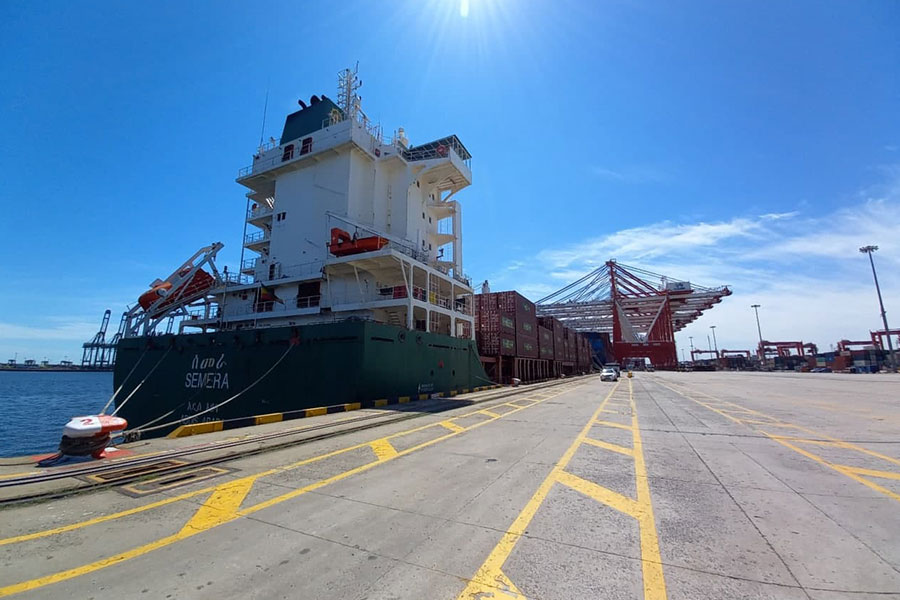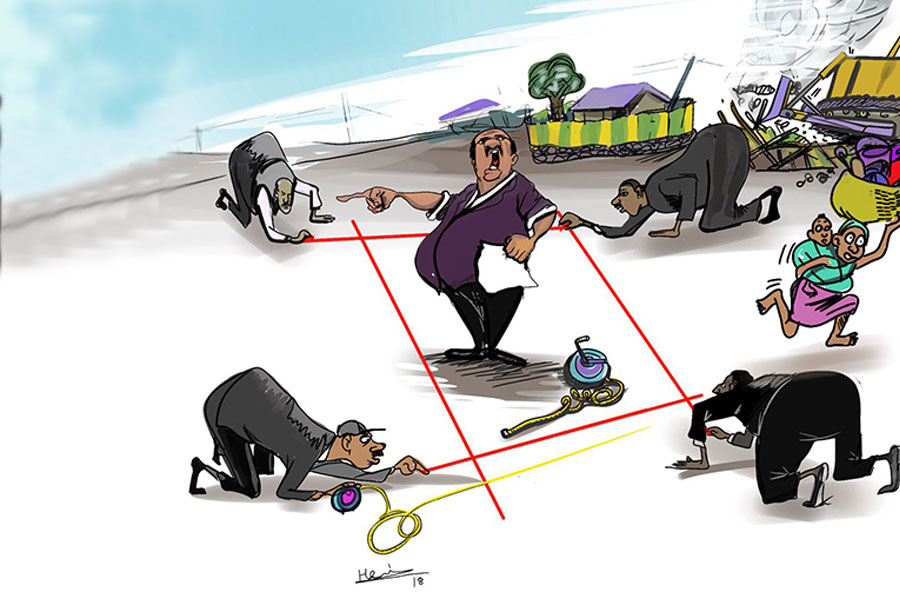
Advertorials | Jun 05,2023
Qobo in North Wello of the Amhara Regional State is where Admassie Tikuye, a farmer, has lived his whole life. He harvests up to five quintals of barley, millet, and oats annually from a few hectares of land he inherited from his forefathers. When conflict erupted a year ago between the federal government and armed forces in Tigray Regional State, Admassie was wary but never thought it would directly affect him.
The conflict engulfed his village and areas hundreds of kilometres southbound to the capital in less than a year. He, and four of his children, fled from Qobo a month ago, finding refuge in Dessie, 160Km from his home. They found shelter in Addis Fana School, one of the government-run temporary shelters housing hundreds of thousands of people in the Regional State.
Dessie, too, alongside Combolcha, fell to the hands of the armed forces in Tigray last week. But Admassie was hoping to move to Addis Abeba, where one of his daughters lives.
"I'll try to go there," he told Fortune.
Admassie is one of the 407,000 smallholder farmers in Qobo and the surrounding area of the North Wello region known for producing cereals such as teff, wheat and sorghum. Last year, the area harvested 5.1 million quintals of these crops, accounting for close to five percent of total production in the Amhara region. This is likely to plummet this year as one of the many consequences of the civil war raging in the country.
The loss of lives, economic shock, widespread hunger, disease and destruction of property are among the long list of calamities left in the wake of the fighting between the federal army and its allies in the Amhara region against the military forces in Tigray. As time goes on, more is added to the list of this grim and alarming state. The most recent is the devastating effects the war has had on agricultural output. The sheer scale is even more startling, considering agriculture accounts for 35pc of Ethiopia`s gross domestic product (GDP).
It is the only means of livelihood for nearly 80pc of the population. More than 15 million smallholder farmers like Admassie are engaged in the production of cereals, harvesting close to 13 million hectares of land. According to officials from the regional state, the war left close to 300,000ht of land in the Amhara region unploughed this year. This includes 67 weredas in the regional state, where Admassie and untold numbers of farmers are displaced.
The crop output estimated to be lost this year in the Amhara Regional State makes up about 15pc of the region's total production.
In two zones of Afar Regional State, constituting 14 weredas, 17,000ht of land was not cultivated as over half a million people were displaced, according to Esayas Lemma, director of crop development at the Ministry of Agriculture.
“The major causes for the loss of crops is looting of agricultural inputs, harvested products and the inability of farmers to tend to their farmlands as they are displaced,” Esayas told Fortune. "Those cultivated are left vulnerable to weeds, flooding and disease."
A loss of 14.5 million quintals of crops (13pc of annual production) is projected in Amhara Regional State alone, according to a report from the Ministry of Agriculture. Esayas points out that the farmers themselves will be the worst affected by the developments, as close to 75pc of the output is a product of subsistence farming.
The situation in Tigray is as bleak.
Cultivating close to one million hectares of land, farmers in Tigray produce 20 million quintals of crops annually. However, officials of the Agriculture Ministry have little to no information about farming in the regional state ever since the armed forces in Tigray controlled much of the region in July this year. Neither is the fate of 150 million Br worth of seeds and fertiliser distributed last year to farmers in Tigray known to officials of the Ministry.
"We're considering outputs from Tigray as a total loss," said Esayas. "We're not expecting anything anymore."
This has led to a growing fear among those following agricultural productivity in Ethiopia that last year's harvest of 341 million quintals of grain will be unattainable. A third of this crop came from the warn-torn Amhara and Tigray regional states, the latter accounting for six percent of national grain production. As the war spills over farther into Northern Shoa, millions of quintals of crops are at risk of loss.
Areas in South Gonder such as Ga'int and Wag Hemra of North Wello (Raya, Kobo, Alamata) have been severely affected by the war. Farmers and their families have been fleeing southward, seeking shelter from the violence. Their priority is to preserve their lives and their loved ones.
Ayalnesh Fisseha, 40, was one of these farmers from Qobo sheltered in the same school as Admassie. She had high hopes to harvest 20 quintals of teff, and when the fighting reached her village in August she was forced to run away with two of her young children. Separated from her husband, Ayalnesh has not seen him since her journey to Dessie, where her children are crying, hungry.
Like many farmers temporarily sheltered in the school, she is doing all she can to stay alive, buying food from outside the shelter. Shelves were quickly going empty. A small city under the shadow of hills and mountains, Dessie was overcrowded far beyond its capacity to absorb over half a million displaced people. Supplies were not moving to it in sufficient volume; neither was there enough in emergency humanitarian assistance.
Over 1.7 million people like Admassie and Ayalnesh have been displaced from the active combat areas of the Amhara region, while 5.4 million people need humanitarian assistance.
"We need help from the government," Ayalnesh pleaded.
Federal and regional authorities claim they were doing what they could. Gizachew Muluneh, head of communications for the Amhara regional government, says the administration delivers food to internally displaced sheltered places like Dessie. However, as the war spreads, it has become challenging to continue, and the government's effort to reach out to the population in Dessie and Combolcha was discontinued beginning last week.
The war has also affected the exports of grain crops and oilseeds such as sesame significantly.
The second most important agricultural commodity next to coffee, sesame generates up to 450 million dollars annually. Last year, 309,000 smallholder farmers harvested 2.6 million quintals of sesame cultivated on 369,000ht of land, mainly in the western regions of Tigray (Humera, Welkayit and Tahtay Adiabo) and in central and west Gonder of the Amhara region. Combined, the two regional states account for 90pc of the total sesame produced in the country. It is in these regional states where the scourge of war has been most evident.
Elias Gutu owns an agro-processing company that exports processed sesame mainly to North America. In a good year, the company would ship as much as four million dollars worth of sesame. This year is anything but. His company has been forced to cease operations as supplies have been cut off, although he tried to source sesame from farmers in Humera, an area highly militarized.
"We've lost all communications, and we don't know what's happening besides hearsay," Elias told Fortune.
His company is exploring the venue to export coffee until such time things return to "normal."
It is a hope many thousands displaced and sheltered in Dessie hold. They are desperate to see the war end soon and return to their villages to resume their lives from what they have left off. However, experts warn that rehabilitation will be as daunting.
Seifu Assefa, an agricultural expert who served at the Ministry of Agriculture for eight years, says the provision of farm inputs and technology should be given attention.
"When the displaced farmers move back to their land, they might not find much," he said. “Seeds and technical support should be provided to rehabilitate the farmland."
For farmers like Admassie, the idea of returning to their land might seem far from the realm of what is possible at the moment. The war shows no sign of respite, threatening to overwhelm the capital where he wanted to join his daughter.
PUBLISHED ON
Nov 06,2021 [ VOL
22 , NO
1123]

Advertorials | Jun 05,2023

Commentaries | Jan 27,2024

Radar | Jun 03,2023

Fortune News | May 25,2019

Radar | Jan 18,2020

View From Arada | Sep 14,2024

Radar | Oct 01,2022

Exclusive Interviews | Oct 21,2023

Fortune News | Jun 20,2025

Agenda | Oct 23,2021

Dec 22 , 2024 . By TIZITA SHEWAFERAW
Charged with transforming colossal state-owned enterprises into modern and competitiv...

Aug 18 , 2024 . By AKSAH ITALO
Although predictable Yonas Zerihun's job in the ride-hailing service is not immune to...

Jul 28 , 2024 . By TIZITA SHEWAFERAW
Unhabitual, perhaps too many, Samuel Gebreyohannes, 38, used to occasionally enjoy a couple of beers at breakfast. However, he recently swit...

Jul 13 , 2024 . By AKSAH ITALO
Investors who rely on tractors, trucks, and field vehicles for commuting, transporting commodities, and f...

Oct 4 , 2025
Eyob Tekalegn (PhD) had been in the Governor's chair for only weeks when, on Septembe...

Sep 27 , 2025
Four years into an experiment with “shock therapy” in education, the national moo...

Sep 20 , 2025
Getachew Reda's return to the national stage was always going to stir attention. Once...

Sep 13 , 2025
At its launch in Nairobi two years ago, the Africa Climate Summit was billed as the f...